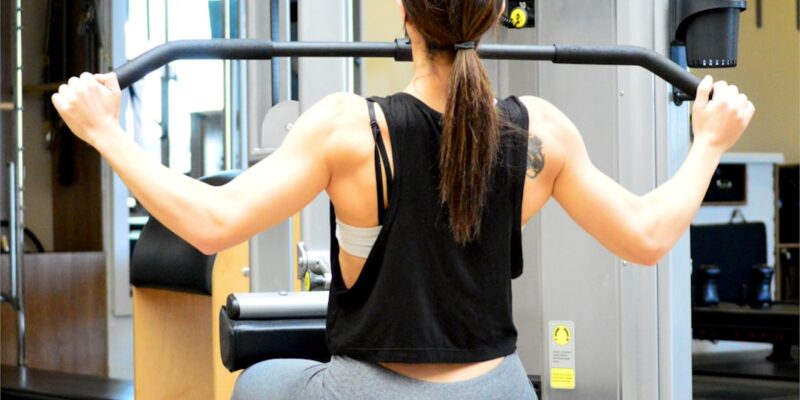
Get Fit and Strong: 7 Must-Try Gym Exercises for Maximum Results with Stunning Visuals
Regular exercise is essential for maintaining overall health and well-being. It not only helps to control weight, but also reduces the risk of chronic diseases such as heart disease, diabetes, and certain types of cancer. Additionally, exercise improves mood, boosts energy levels, and promotes better sleep. While there are many forms of exercise that can be done outside of a gym setting, gym exercises offer a unique opportunity to target specific muscle groups and achieve specific fitness goals.
Gym exercises play a crucial role in achieving fitness goals because they allow for targeted muscle development and strength building. Whether your goal is to lose weight, build muscle, or improve overall fitness, incorporating gym exercises into your routine can help you reach those goals more efficiently. By using various equipment and machines available at the gym, you can isolate specific muscle groups and work on them with greater intensity. This targeted approach allows for faster progress and better results.
Key Takeaways
- Gym exercises are important for achieving fitness goals.
- Squats are the ultimate lower body workout for strength and tone.
- Deadlifts can build core strength and improve posture with proper form.
- Bench press strengthens the chest, shoulders, and triceps for upper body power.
- Pull-ups challenge the back, biceps, and forearms with bodyweight resistance.
Squats: The Ultimate Lower Body Workout for Strength and Tone
Squats are often referred to as the king of all exercises because they engage multiple muscle groups in the lower body, including the quadriceps, hamstrings, glutes, and calves. They are a compound movement that not only strengthens the lower body but also improves core stability and balance.
Proper form and technique are crucial when performing squats to avoid injury and maximize results. Start by standing with your feet shoulder-width apart and toes slightly turned out. Lower your body by bending at the knees and hips, keeping your chest up and back straight. Aim to lower until your thighs are parallel to the ground or slightly below, then push through your heels to return to the starting position.
There are several variations of squats that can be done to accommodate different fitness levels. Beginners can start with bodyweight squats or use a stability ball against a wall for support. As you progress, you can add resistance by using dumbbells, barbells, or kettlebells. Other variations include sumo squats, Bulgarian split squats, and pistol squats.
Deadlifts: Building Core Strength and Improving Posture with Proper Form
Deadlifts are another compound exercise that targets multiple muscle groups, including the hamstrings, glutes, lower back, and core. They are excellent for building overall strength and improving posture.
To perform a deadlift, start by standing with your feet hip-width apart and a barbell in front of you. Bend at the hips and knees to lower your body and grip the barbell with an overhand grip. Keep your back straight and chest up as you push through your heels to lift the barbell off the ground. Stand up straight, squeezing your glutes at the top of the movement, then lower the barbell back down with control.
Proper form is crucial when performing deadlifts to avoid injury. It is important to keep your back straight throughout the movement and engage your core muscles for stability. If you are new to deadlifts, it is recommended to start with lighter weights or use a trap bar for a more beginner-friendly variation.
Bench Press: Strengthening the Chest, Shoulders, and Triceps for Upper Body Power
| Exercise | Muscles Worked | Equipment Needed | Repetitions | Sets | Rest Time |
|---|---|---|---|---|---|
| Bench Press | Chest, Shoulders, Triceps | Barbell, Bench | 8-12 | 3-5 | 1-2 minutes |
The bench press is a classic gym exercise that primarily targets the chest muscles (pectoralis major and minor), but also engages the shoulders (deltoids) and triceps. It is an excellent exercise for building upper body strength and power.
To perform a bench press, lie flat on a bench with your feet flat on the ground. Grip the barbell slightly wider than shoulder-width apart and lower it to your chest while keeping your elbows at a 45-degree angle. Push the barbell back up until your arms are fully extended, then repeat.
Proper form and technique are essential when performing the bench press to avoid injury and maximize results. It is important to keep your back flat against the bench, engage your core muscles for stability, and use a controlled motion throughout the movement. Beginners can start with lighter weights or use dumbbells instead of a barbell for added stability.
Pull-Ups: Challenging the Back, Biceps, and Forearms with Bodyweight Resistance
Pull-ups are a challenging exercise that primarily targets the back muscles (latissimus dorsi), but also engages the biceps and forearms. They are an excellent exercise for building upper body strength and improving grip strength.
To perform a pull-up, start by gripping a pull-up bar with your palms facing away from you and your hands slightly wider than shoulder-width apart. Hang from the bar with your arms fully extended, then pull your body up until your chin is above the bar. Lower yourself back down with control and repeat.
Proper form and technique are crucial when performing pull-ups to avoid injury and maximize results. It is important to engage your core muscles for stability and use a controlled motion throughout the movement. If you are new to pull-ups or find them too challenging, you can start with assisted pull-ups using a resistance band or use a pull-up machine that provides assistance.
Lunges: Sculpting the Legs and Glutes with Dynamic Movement and Control
Lunges are a versatile exercise that primarily targets the quadriceps, hamstrings, glutes, and calves. They are excellent for sculpting the legs and glutes while also improving balance and stability.
To perform a lunge, start by standing with your feet hip-width apart. Take a step forward with one foot and lower your body until both knees are bent at a 90-degree angle. Push through your front heel to return to the starting position, then repeat on the other side.
Proper form and technique are important when performing lunges to avoid injury and maximize results. It is important to keep your chest up, back straight, and engage your core muscles for stability. Beginners can start with bodyweight lunges or use dumbbells for added resistance. Other variations include walking lunges, reverse lunges, and lateral lunges.
Planks: Developing Core Stability and Endurance with Variations for All Levels
Planks are an isometric exercise that primarily targets the core muscles, including the rectus abdominis, transverse abdominis, and obliques. They are excellent for developing core stability and endurance.
To perform a plank, start by lying face down on the ground. Place your forearms on the ground with your elbows directly under your shoulders. Lift your body off the ground, balancing on your forearms and toes. Keep your body in a straight line from head to toe, engaging your core muscles for stability. Hold this position for as long as you can while maintaining proper form.
Proper form and technique are crucial when performing planks to avoid injury and maximize results. It is important to keep your body in a straight line and avoid sagging or lifting your hips too high. Beginners can start with modified planks by balancing on their knees instead of their toes. Other variations include side planks, plank jacks, and plank with leg lifts.
Rows: Targeting the Upper and Mid-Back for Improved Posture and Functionality
Rows are an excellent exercise for targeting the upper and mid-back muscles, including the rhomboids, trapezius, and rear deltoids. They are great for improving posture and functionality.
To perform a row, start by standing with your feet hip-width apart and a dumbbell in each hand. Hinge forward at the hips while keeping your back straight and chest up. Bend your elbows and pull the dumbbells towards your chest, squeezing your shoulder blades together. Lower the dumbbells back down with control and repeat.
Proper form and technique are important when performing rows to avoid injury and maximize results. It is important to keep your back straight and engage your core muscles for stability. Beginners can start with lighter weights or use resistance bands instead of dumbbells for added support. Other variations include bent-over rows, seated rows, and single-arm rows.
Push-Ups: Engaging the Chest, Shoulders, and Triceps with Versatile Variations
Push-ups are a classic bodyweight exercise that primarily targets the chest muscles (pectoralis major and minor), but also engages the shoulders (deltoids) and triceps. They are a versatile exercise that can be modified to accommodate different fitness levels.
To perform a push-up, start in a high plank position with your hands slightly wider than shoulder-width apart. Lower your body by bending at the elbows while keeping your body in a straight line from head to toe. Push back up until your arms are fully extended, then repeat.
Proper form and technique are crucial when performing push-ups to avoid injury and maximize results. It is important to keep your body in a straight line and engage your core muscles for stability. Beginners can start with modified push-ups by balancing on their knees instead of their toes. Other variations include wide grip push-ups, diamond push-ups, and decline push-ups.
Incorporating These Exercises into Your Gym Routine for Maximum Results
Incorporating a variety of exercises into your gym routine is essential for achieving maximum results. By targeting different muscle groups and using various equipment, you can challenge your body in different ways and prevent plateaus.
To incorporate these exercises into your gym routine, start by selecting a few exercises from each category that target different muscle groups. For example, you could include squats, deadlifts, bench press, pull-ups, lunges, planks, rows, and push-ups. Aim to perform each exercise 2-3 times per week, allowing for rest days in between to allow for muscle recovery.
In addition to regular exercise, it is important to maintain a balanced diet to support your fitness goals. Eating a variety of nutrient-dense foods, including lean proteins, whole grains, fruits, and vegetables, will provide your body with the fuel it needs to perform at its best.
Consistency is key when it comes to achieving fitness goals. By incorporating these exercises into your gym routine and maintaining a balanced diet, you will be well on your way to achieving the results you desire. Remember to listen to your body and make adjustments as needed to ensure safety and progress.
If you’re looking for more fitness inspiration, check out this article on Wave Magnets that showcases the benefits of magnetic therapy for athletes and gym-goers. Magnetic therapy has gained popularity in recent years for its potential to enhance performance, reduce pain, and accelerate recovery. Discover how incorporating magnetic therapy into your fitness routine can complement the 7 most effective exercises to do at the gym. Learn more about the power of magnets and their impact on athletic performance by visiting Wave Magnets.
FAQs
What are the 7 most effective exercises to do at the gym?
The article lists the following exercises as the most effective: squats, deadlifts, bench press, pull-ups, lunges, rows, and overhead press.
Why are these exercises considered the most effective?
These exercises are considered the most effective because they work multiple muscle groups at once, allowing for a full-body workout. They also help to build strength and improve overall fitness.
Do I need to be an experienced gym-goer to do these exercises?
No, these exercises can be modified to fit any fitness level. It is important to start with lighter weights and proper form to avoid injury.
How many sets and reps should I do for each exercise?
The number of sets and reps will vary depending on your fitness goals. Generally, it is recommended to do 3-4 sets of 8-12 reps for each exercise.
Can I do these exercises at home?
Some of these exercises can be done at home with the proper equipment, such as dumbbells or resistance bands. However, it is recommended to do these exercises at the gym with access to heavier weights and machines.
What are the benefits of doing these exercises?
The benefits of doing these exercises include building strength, improving overall fitness, increasing muscle mass, and boosting metabolism. They also help to prevent injury and improve posture.


















